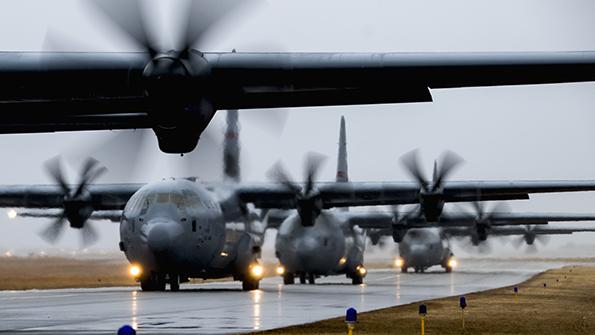U.S. Palletized Munitions Concept May Become Reality In 2021

To win a war with China, the U.S. military must have the ability to strike thousands of targets within a fleeting timespan. The U.S. Air Force plans to host a demonstration in 2021 in which Lockheed Martin will employ a roll-on/roll-off pallet system designed to enable the air launch of dozens of long-range cruise missiles from Boeing C-17s and Lockheed Martin C-130s.
If the Air Force decides to go this route, the C-17 and C-130 fleets will evolve into standoff bombers with more firepower than the 24 Joint Air-to-Surface Standoff Missile-Extended Range (JASSM-ER) missile capacity inside a Boeing B-1B weapons bay. The service conducted five high-altitude airdrops from an MC-130J and a C-17 in 2020 with simulated weapons.
The Pentagon dusted off the palletized-munition concept in 2016 when the Strategic Capabilities Office (SCO) announced plans to experiment with an arsenal plane by converting existing mobility aircraft into a bomber-type role. But the SCO has revised its idea. Instead of using existing mobility, the office now wants to produce a new aircraft to use as an arsenal plane.
- Finalized KC-46 vision system design on the horizon
- U.S. Air Force C-130H retirement remains undecided
Air Mobility Command is on board with expanding its transport fleet to carry long-range strike weapons, similar to the scenario planned for the 2021 demonstration. However, not everyone in the Air Force agrees. Gen. Timothy Ray, head of Global Strike Command, would rather the service purchase additional bombers instead of relying on mobility aircraft.
This is one of many issues the Air Force faces involving transport aircraft. Others include the fate of the Boeing KC-46A Pegasus tanker-transport and the future of the service’s C-130 fleet.
Regarding the KC-46A, the Air Force expects to decide in 2021 on a new projection method for the remote vision system (RVS), a technology akin to virtual or augmented reality. To correct a “rubber-sheeting” effect that distorts the image on a visual display used by the boom operator during refueling operations, the team is considering a liquid-crystal-display (LCD) screen or a “collimated mirror design" for the RVS projection method.
After a projection design is selected, a laboratory will build the system to test each new component to give the team confidence before installing the new equipment on the actual aircraft.
In 2021, the Pentagon likely will see a need for additional intratheater airlifters. The head of U.S. Transportation Command, Gen. Stephen Lyons, anticipates the Defense Department’s delayed Mobility Capabilities and Requirements Study will wrap up in the spring. “I think you’re going to see some increased demands,” Lyons says.
Although there probably will be a need for more airlifters, the Air National Guard (ANG) says it requires flexibility to retire C-130Hs so it can fund upgrade programs the Pentagon has long ignored for the rest of the C-130 fleet.
“The question now is: How do we make sure these platforms are survivable, lethal and interoperable with the other platforms in the joint force?” ANG Director Lt. Gen. Michael Loh says.
He is working with Congress and the Joint Staff to gain authority to retire the aging C-130Hs and help the ANG and Air Force Reserve upgrade to the J model (AW&ST Nov. 9-22, p. 45).
The Air Force has announced four preferred locations to house ANG C-130Js to replace the Hs, though it had told Congress three would be chosen. The preferred locations are: Louisville ANGB, Kentucky; McLaughlin ANGB, West Virginia; NAS Joint Reserve Base in Texas; and Savannah ANGB in Georgia.
The Air Force selected four bases instead of three because the House and Senate spending bills include funding for additional C-130Js, according to service spokeswoman Ann Stefanek. “Naming the preferred alternatives now allows us to move forward with the environmental-impact process without delay, enabling the timely bed down of these C-130Js,” Stefanek says.
House Armed Services Committee Chairman Adam Smith (D-Wash.) believes the decision is politicized because of the Jan. 5 U.S. Senate runoff elections in Georgia, saying: “While the rigor of the strategic basing process may support the selection of these four locations, the timing of the announcement raises serious concerns.”
Meanwhile, European air forces are continuing to transition their transport fleets to the Airbus A400M and expanding its role to tactical transport and aerial refueling. Germany is deploying one of its tanker-equipped A400Ms to Jordan for operations over Iraq and Syria. During 2020, Airbus cleared simultaneous paratroop dispatch from the side paratroop doors and tested the helicopter’s air-to-air refueling capacity, which the company hopes to certify during 2021.
While the A400M has yet to find an export customer beyond Malaysia, Airbus has stepped up marketing efforts with demonstrations to Kazakhstan. The aircraft reportedly is facing off against Japan’s Kawasaki C-2 for a tender in the United Arab Emirates, performing rough-field landing trials in support of the bid.
Airbus continues to secure orders for the A330-based Multi-Role Tanker Transport, with additional aircraft ordered by France and the NATO Multi-national Multi-Role Tanker Transport Fleet. Spain is expected to order three MRTT conversions. Leonardo has been working to advance its C-27J Spartan offering to existing operators with an updated version, featuring a modernized avionics suite and winglets, which should help to boost maximum takeoff weight. First delivery of the C-27J Next Generation is planned for 2021.
The collapse of the Boeing-Embraer joint venture on the C-390 Millennium airlifter in April does not seem to have hindered export opportunities, even in the subdued airlifter market. The Brazilian aircraft has secured a second European customer with Hungary’s order of two aircraft placed in November. Portugal ordered five KC-390s in 2019; assembly of the first one is well underway.
Editor's note: This story was updated to correct the fact that the team is considering a "collimated mirror design" for the Remote Vision System projection method.



Comments